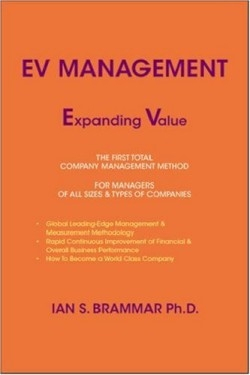EV Management
Expanding Value
Dr. Brammar takes a dim view of certain improvement paradigms like Lean Manufacturing which promise miracle savings through little more than streamlining work stations or production lines. If every second of waste is cut from the making of a widget and the company still isn’t meeting the value growth benchmarks of a world class company maybe that’s because only limited progress is possible working solely from the bottom up.
EV Management is a new top-down company-wide approach formulated by one of Australia’s most respected experts. It aims to increase the percentage of time spent on value-added activity throughout a manufacturing organization working on both external and internal strategies one carefully ordered step at a time. When applied properly employees and managers at all levels become personally invested integrated measurements make progress entirely trackable and productivity gains cause a rise in sales rather than layoffs of the newly redundant. EV replaces the “us vs. them” mentality with an upward spiral of win-win if handled properly.
Speaking of divisions between top managers and the rank and file the author identifies a surprising cause: higher-ups process information by a mix of visual and auditory while lower level employees strongly favor kinesthetic (emotions-based) exchanges. The senior manager who learns the other language cues and symbols will unite the team. When the EV is presented with transparency and worker input is genuinely requested participation is very good. The author points out “as a general rule people much prefer to work on value adding activities!”
The array of strategies and tactics take in multiple trouble spots overlooked by other paradigms. At its heart EV is a combination of the wildly successful Toyota Production System and the sophisticated Socio-Technical Systems of the UK’s Tavistock Institute topped by the “Brammar Cycle” which is the grandson of the Deming Cycle. The author states that this system contains such precision that senior managers who buy into it will become immune to personality conflicts. After all contention comes from lack of agreement about an organization’s central goals and direction.
Unfortunately the author’s notable ideas aren’t communicated with nearly enough clarity. Without a background in designing analyzing and auditing quality systems this reviewer would have certainly become hopelessly confused in the book’s early chapters. This is a shame because the approach comes out of shrewd thinking. Brammar expects ninety-five percent of senior managers within those companies who will use EV to understand the details of this plan. Given the readability of the material some bright people won’t be able to follow the writing.
Brammar’s credentials are impeccable from his leadership within the Australian metals industry to problem-solving triumphs in the UK and elsewhere. Leaders of companies wishing to emerge from conventional expectations have much to learn from the Expanding Value approach. They’d be well advised to study this book until they can sort it out.
Reviewed by
Todd Mercer
Disclosure: This article is not an endorsement, but a review. The publisher of this book provided free copies of the book and paid a small fee to have their book reviewed by a professional reviewer. Foreword Reviews and Clarion Reviews make no guarantee that the publisher will receive a positive review. Foreword Magazine, Inc. is disclosing this in accordance with the Federal Trade Commission’s 16 CFR, Part 255.

